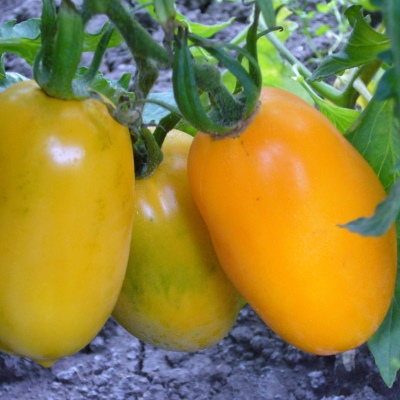
- Authors: Gubko V.N., Chernovolova O.A.
- Year of approval: 2007
- Category: grade
- Growth type: indeterminate
- Appointment: fresh consumption
- Ripening period: late ripening
- Growing conditions: for open ground, for film greenhouses
- Transportability: Yes
- Bush height, cm: 120
- Leaves: large, green
Olesya is a Russian-bred tomato variety, approved for use in 2007. The variety has its own characteristics and is suitable for growing novice gardeners.
Description of the variety
The indeterminate bush reaches a height of 120 cm, the stems are fragile, the foliage is medium. The leaves are large, green, tomato-like, slightly drooping. Simple inflorescences are formed on 4-5 clusters on one stem, up to 9 flowers develop on a branch. The root system of the plant is pivotal with many processes, the stalks are strong and powerful.
The main qualities of the fruit
An unripe tomato has a green color, the skin of a ripe fruit is orange. Tomatoes weigh 120-200 g, develop in the shape of an ellipse. They have good keeping quality and transportability.
Taste characteristics
To taste, Olesya's tomatoes are sweet, their pulp is dense, fleshy. The taste is brightly revealed in a fresh salad, and the fruits can also be used to make juice or sauce.
Whole fruit canning is permissible, pickled orange elliptical tomatoes will add aesthetics to any dish, however, judging by the reviews of many consumers, the peel of Olesya's tomatoes bursts under the influence of high temperatures.
Ripening and fruiting
Olesya belongs to varieties with a late ripening period, harvesting usually falls in July-September.
Yield
The productivity of the presented variety largely depends on compliance with the rules of agricultural technology. When grown under optimal conditions, the yield is average and amounts to 4.7 kg / sq. m.
The timing of planting seedlings and planting in the ground
Sowing is carried out in March-April. Before planting, the seeds are recommended to be disinfected in a solution of potassium permanganate and held in a growth stimulator. When planting, the seeds are buried 1-1.5 cm.
Tips for the care of seedlings.
- If you immediately sow in separate containers, then the crop can be harvested a week earlier.
- Keep the seedlings at a temperature of + 22 ... +26 degrees.
- Maintain 12-15 hours of daylight, it is recommended to use special lighting fixtures.
- Make a pick when 2-3 true leaves appear.
- Start hardening seedlings a week before transplanting. Take them outside every day, over and over again increasing the time you spend in the fresh air.
- A transplant to a summer cottage occurs in May-June, that is, 50-60 days after the emergence of shoots. Usually, by this age, the height of the seedlings is 25-27 cm.

Growing tomato seedlings is an extremely important process, because it largely depends on whether the gardener will be able to harvest at all. All aspects must be taken into account, from seedbed preparation to planting in the ground.
Landing scheme
It is allowed to plant seedlings of the Olesya variety both in a film greenhouse and in open ground. The bushes are arranged according to the 50x70 cm scheme.

Growing and caring
Care for the planted shoots is as follows.
- Tie the stems to a support, form a two-stem culture.
- Remove stepsons at a height of 5-6 cm.
- Water the tomatoes every 1-3 days if grown in a greenhouse. When planting in open ground, be guided by the climatic conditions. Use 8 liters of water per dose for each bush.
- Feed the plant with complex formulas including nitrogen, phosphorus and potassium. Conduct regular foliar feeding with urea, boric acid, growth stimulants.
- If the culture is planted in a greenhouse, then maintain a humidity of 60-70%, as well as a temperature not higher than +30 degrees. Ventilate the greenhouse.




A plant needs different micronutrients at each stage of growth. All fertilizers can be divided into two groups: mineral and organic. Folk remedies are often used: iodine, yeast, bird droppings, eggshells.
It is important to observe the rate and period of feeding. This also applies to folk remedies and organic fertilizers.
Disease and pest resistance
The Olesya variety is rarely affected by fungi, including late blight, however, to prevent ailments, preventive measures are required, which consist in moderate watering, regular airing of the greenhouse, mandatory dressing and periodic treatment with Fitosporin.
Among the insects that are attracted by the Olesya variety, aphids and whiteflies should be noted. Treatment with soapy water or potassium permanganate helps to cope with them. In case of damage before the flowering stage, insecticides or acaricides are used in accordance with the instructions.



























































































